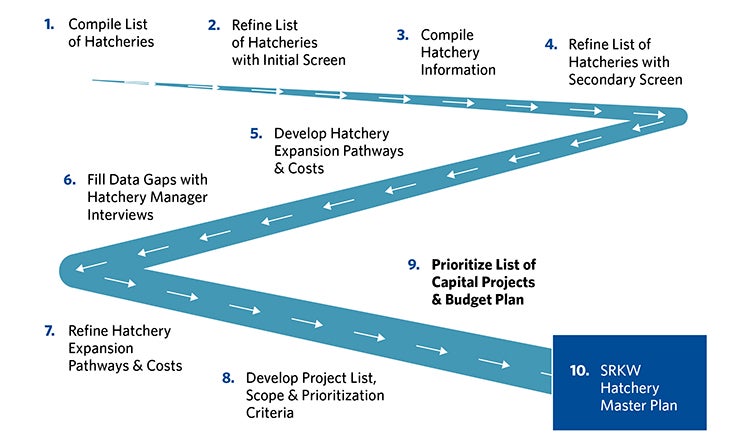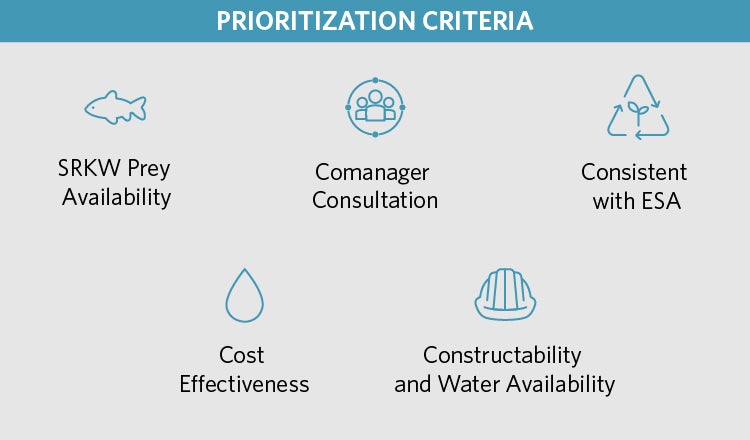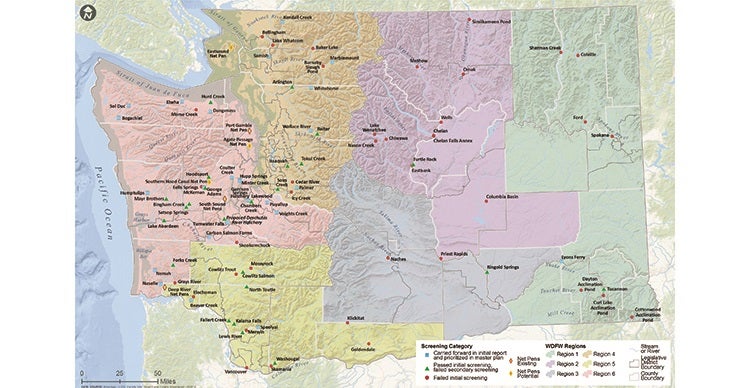
Master Planning for Killer Whales
A Fishery Master Plan Case Study
The Salish Sea is an integral feature of the Pacific Northwest that has been used for thousands of years for transportation, trade and sustenance. It’s an “inland sea” composed of the Strait of Juan de Fuca, Puget Sound, Hood Canal, the San Juan Islands, the Gulf Islands and the Georgia Straits. This inland sea has many endearing attributes that make it part of the region’s unique culture and identity. The most iconic representatives of the Salish Sea are the Southern Resident Killer Whales (SRKWs; Orcinus orca), which are native to the region and distinguished as a Distinct Population Segment by the National Marine Fisheries Service.
In the Pacific Ocean, killer whales exhibit several life histories including transients, offshores and residents. Transient and offshore killer whales forage primarily on marine mammals and sharks, respectively. However, resident killer whales like the SRKWs have evolved to forage on fish, with salmon as their preferred prey items in the Salish Sea and along the 1,000-mile stretch of the Pacific Coast. In fact, in the summer and spring when SRKWs occupy inland waters of the Salish Sea, they feed almost exclusively on Chinook salmon (Oncorhynchus tshawytscha), and for good reason. The Salish Sea and adjacent coastal waters are migratory corridors and foraging areas for historically large salmon runs emanating from Columbia River, Fraser River, coastal and Salish Sea rivers. Historically, the Salish Sea was an ideal habitat for killer whales, as there was very little pressure on the habitat and prey they had evolved to exploit.
Be the first to know
Subscribe to receive our Water Insights
Pressure has been brought to bear on SRKW habitat over time, and along with other limiting factors, SRKWs are now listed as an endangered species by the state and federal government. Despite these regulatory protections, the population continues to decline in both fitness and abundance and has recently dropped to only 73 individuals — the lowest level in over four decades. SRKWs face several complex threats: a severe reduction in salmon prey items (particularly Chinook salmon), disturbance from noise and vessel traffic, toxic contaminants and emerging effects of climate change. The current lack of Chinook salmon availability is believed to contribute to poor SRKW health and reproductive failure.
Increasing the availability of Chinook salmon for SRKW consumption is one of the many tools that could contribute to SRKW recovery. Increased Chinook salmon prey availability could be achieved in several ways, including increasing natural and hatchery production. Programs intended to increase natural production through restoring habitats, correcting fish passage barriers, improving survival through the hydropower systems and decreasing predation of juvenile salmon are state and federal priorities and the subjects of ongoing implementation. Increasing hatchery production at existing and proposed new state facilities may more immediately increase SRKW prey availability. Combined with habitat improvements to address pollutants (including contaminants and vessel noise) in SRKW marine waters, increasing natural and hatchery Chinook salmon production may provide the best chance to assist SRKW recovery.
In 2018, Washington Governor Jay Inslee established Executive Order 18-02, directing a task force to recommend immediate and long-term actions to benefit SRKWs. Of these, one recommendation was to increase hatchery production by 50 million smolts (i.e., juvenile salmon). To meet this goal, since 2018, the Washington Department of Fish and Wildlife, as well as several tribes and one utility, have increased hatchery production at existing facilities through modified operations and maximized facility use. These efforts increased hatchery production by over 26 million anadromous salmon (of all species), including over 9 million Chinook salmon. In concert with these efforts, the Washington state legislature directed the WDFW to develop a SRKW Hatchery Master Plan that would define a roadmap to increase the production of hatchery Chinook salmon to benefit SRKWs in a manner consistent with existing state and federal policies.
To that end, the WDFW partnered with HDR in July 2020 to develop the master plan. We led the planning process with expertise in hatchery planning, design, cost estimation and an economic-based benefits risk analysis. WDFW worked very closely with our team to facilitate information exchange and leverage the critical knowledge of WDFW regional and hatchery managers. WDFW used information expressed in previous informal discussions with co-managers to, in turn, leverage their knowledge and expectations for stock management. Co-manager consultation is important and will continue consistent with WDFW policy for communication, coordination and consultation with tribal governments. Close coordination was important not only for information exchange but also because of the short project timeline and challenges from COVID-19 work restrictions. Because legislative funding was not available until the beginning of the fiscal year (July 1, 2020) and the master plan was due to the legislature by January 15, 2021, the planning process was compressed into a very aggressive schedule. COVID-19 work restrictions required all meetings to be held virtually with limited site visits.

Facility Screening
To develop this master plan, the WDFW and HDR team implemented a screening and planning process. The screening evaluation helped the team target hatcheries for further evaluation and project development. An initial screening step removed from consideration most non-WDFW-owned hatcheries (with a few exceptions), state hatcheries that do not produce salmon, and hatcheries that may not produce additional Chinook salmon, pursuant to the Endangered Species Act and recovery plan production limits. For ESA constraints, a facility was only screened out from further consideration if successful re-initiation of ESA consultation (for increased production) was unlikely. The goal of ESA constraints is to protect the genetic integrity of native salmonid stocks in the watersheds where hatchery production is occurring.
Mixing of adult hatchery and native salmon of the same species in the same river may lead to genetic mixing, which, over several generations, may decrease the genetic integrity of the native stock that has evolved to specific conditions in that watershed. These constraints are documented in the recovery plans crafted by state, federal and tribal co-managers.
The second screening step characterized the refined list of hatcheries to better understand their capacity for expanded production. Additional facilities were removed from further evaluation based on site-specific factors, including land and water availability to support new development, or hatchery production constraints under existing state and federal policies including the ESA. This evaluation required a “deep dive” into facility details, such as water rights, water infrastructure, land availability, management objectives and constraints. These remaining hatcheries were further evaluated as projects.
Finally, two new WDFW hatcheries were proposed as part of this master plan: the Deschutes River Hatchery and the Cowlitz River Hatchery. These hatcheries were proposed because of their potential for large contributions to the goal of 50 million new salmon smolts and their consistency with regional recovery plans and tribal co-manager support.
Project Definition and Cost Estimating
The next step in the master planning process was to define the improvement and expansion projects at each facility that passed through screening, and then prioritize these improvements based on specific criteria. For each facility, potential Chinook salmon production, new infrastructure requirements (e.g., incubation and rearing units, flow rates, additional water needs), and costs were developed. Proposed infrastructure improvements and costs were defined in the context of the WDFW’s existing 10-year capital plan for hatchery infrastructure. The CP targets infrastructure improvements necessary for the maintenance of the state's hatchery facilities, regardless of the SRKW prey enhancement directive. For example, if a CP project was occurring at a facility, those improvements may affect the nature or timing of a SRKW Hatchery Master Plan project.
Hatchery improvements incorporated Partially Recirculating Aquaculture System components, whenever feasible, to increase their hatchery system resiliency over time. PRAS reuses water with treatment and can produce a given quantity of salmon with less water than traditional “single-pass” methods. WDFW recognized that increasing pressure on Washington’s surface and groundwater resources, along with climate change, will make it harder to meet existing fish production goals. Incorporating PRAS whenever feasible can mitigate these current and future water resource limitations, while increasing capacity for production. By incorporating PRAS into the master plan, the WDFW is charting a new course for modernization of their hatchery system.
Project Prioritization and Budgeting
Following the identification of potential expansion projects, WDFW and HDR bundled the facility improvements into pathways. In some cases, these pathways included more than one facility to expand Chinook salmon production; however, most pathways were contained within a single facility. Pathways also included acclimation and release at existing or new marine net pens. Each pathway was prioritized based on prey availability, comanager consultation, consistency with ESA regulations, constructability and water availability, and cost-benefit ratio.
The prioritization scoring and capital costs were used to develop an implementation schedule and budget request for SRKW prey enhancement pathways proposed in this master plan for each fiscal biennium, through FY 45-47. Cost centers for each biennium included predesign, design and construction. In some cases, construction for one project exceeded one biennium. The implementation schedule was developed relative to an approximate biennial budget of $15 million, plus applied escalation.

Conclusion
The master plan identified a Chinook salmon production increase of approximately 36.425 million fish from improvements at existing facilities and from two new state hatchery facilities (Deschutes River Hatchery and Cowlitz River State Salmon Hatchery) that would support SRKW prey production. When combining the master plan targets, WDFW's ongoing annual program of over 9.125 million Chinook salmon for SRKW prey enhancement, and 5.35 million Chinook salmon from tribal and utility production initiated in 2018, the total potential goal for Chinook salmon (approximately 51 million) now exceeds the EO 18-02 goal of 50 million Chinook salmon smolts.
During implementation over the next several biennia, projects must undergo co-manager consultation, consider the need for coordination with landowners for facility development, compliance with environmental regulations, compliance with dynamic hatchery programs and policies, coordination with public interest groups, and implementation of long-term monitoring plans to verify the programs are meeting established goals and objectives. WDFW will coordinate with co-managers and regulators on policies established under the ESA to confirm the long-term viability of proposed production pathways.
WDFW will continue to coordinate with other partners, including federally operated hatchery facilities, tribal hatcheries, upper Columbia facilities and private facilities, to determine if additional SRKW prey enhancement is possible in concert with ongoing production and the production goals recommended herein. Consultation with the Oregon Department of Fish and Wildlife will also occur to determine if Columbia Basin hatcheries in Oregon have the capacity to participate in the effort to enhance salmonid prey for SRKW.

Implementation of the master plan and realization of its benefits to the SRKW will occur cumulatively over the next several biennia. Immediate production increases from available capacity (9.125 million from the WDFW and 5.35 million Chinook from tribal and utility production) will be followed by cumulative implementation of the SRKW Master Plan projects. The benefits of these production increases will need to be monitored in terms of actual prey availability to the SRKW, contributions from natural Chinook production, and in the context of other challenges to SRKW population viability, such as disturbance from noise and vessel traffic, toxic contaminants and the emerging impacts of climate change. As development in the Salish Sea watershed intensifies over time, careful management of our resources becomes increasingly important. Hatchery master planning, incorporation of technology such as PRAS and coordination with co-managers are vital to contributing to the future viability of the SRKW.
About the Authors
Contact Chad Wiseman at chad.wiseman [at] hdrinc.com (chad[dot]wiseman[at]hdrinc[dot]com) or at +1 (360) 570-4427 and Becky Holloway at becky.holloway [at] hdrinc.com (becky[dot]holloway[at]hdrinc[dot]com) or at +1 (425) 263-9111 for more information.
